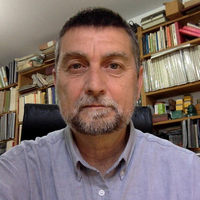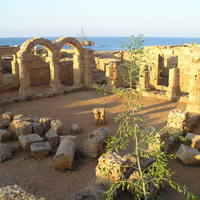Papers by Lázaro Lagóstena

Agri Centuriati. An international journal of landscape archaeology, 2024
In this paper, we analyse the spatial distribution of the well-known amphoric production workshop... more In this paper, we analyse the spatial distribution of the well-known amphoric production workshops in the territoria of the colonia Hasta Regia and the municipium of Gades. One of the most relevant perspectives addressed in the contribution is the analysis of networks and connectivity applied to the figlinae, based on the topographic conditions of the territory, within the framework of the mouths of the Guadalquivir and Guadalete rivers, estuaries linked to the two cities of reference. A priori, it is intended to contrast two models of organisation of this landscape typical of the rural artisan settlements: on the one hand, a model linked primarily to the agricultural activity in the case of Hasta Regia, and, on the other hand, a model more linked to the supply of amphorae for the fish-salting activity in the case of Gades. Therefore, this contribution aims to visualise, quantify, and evaluate the associations and interconnections of production areas going beyond the spatial location of potteries and propose a methodology that allows a synoptic vision of the artisanal organization on the spaces.
Matagorda, 2024
In this contribution we present two case studies based on the application of aerial and terrestri... more In this contribution we present two case studies based on the application of aerial and terrestrial LiDAR techniques for the historical analysis of mining areas in PuertoReal: the case of Los Barreros, for the extraction of clays for ceramic production in the XIX-XX century; and the case of Las Canteras, for the extraction of stone between the XVII-XIX centuries.

Cuadernos De Arqueología De La Universidad De Navarra, 2024
La antigua población de Sabora, mencionada por Plinio, es conocida también a través de un documen... more La antigua población de Sabora, mencionada por Plinio, es conocida también a través de un documento epigráfico, remitido a los Saborenses por el emperador Vespasiano (CIL II 1423), que constata la autorización para el traslado de la ciudad, desde su emplazamiento prerromano en altura hacia una ubicación en llanura, más adecuada al desarrollo de las formas cívicas y los patrones urbanísticos romanos. Si la localización del oppidum primigenio en el municipio malagueño de Cañete la Real se sugiere gracias a la toponimia y la arqueología, no ha sido hasta hace muy poco tiempo, gracias a las exploraciones geofísicas, cuando se ha podido avanzar en la identificación del solar y los vestigios del municipio flavio de Sabora, nacido a raíz del beneplácito imperial, con los restos conservados en el yacimiento de El Carrascal. En esta contribución damos a conocer los datos de carácter urbanístico obtenidos sobre el asentamiento por nuestro equipo, mediante el empleo de un georradar multicanal, y ofrecemos una interpretación de los resultados, argumentando sobre el carácter urbano o villático de los vestigios documentados.
Arqueología y sociedad de los espacios agrarios: en busca de la gente invisible a través de la materialidad del paisaje, 2021, ISBN 978-84-00-10766-6, págs. 109-117, 2021
We present the research project dedicated to Hasta Regia and its territorium. The first phases of... more We present the research project dedicated to Hasta Regia and its territorium. The first phases of the project are dedicated to the updating of the available information on limits and historical occupation of the territory of the Hastense community, as well as the geophysical exploration of its urban centre. Methodologically, we propose an investigation based on non-invasive techniques.
Las cetariae de Ivlia Tradvcta: resultado de las excavaciones arqueológicas en la calle San Nicolás de Algeciras (2001-2006), 2018, ISBN 978-84-9828-700-4, págs. 335-342, 2018
Land, Jun 1, 2023
This article is an open access article distributed under the terms and conditions of the Creative... more This article is an open access article distributed under the terms and conditions of the Creative Commons Attribution (CC BY
Anuario Arqueológico de Andalucía, 2019
UNIDAD DE GEODETECCIÓN DEL PATRIMONIO HISTÓRICO UNIVERSIDAD DE CÁDIZ
Anuario Arqueológico de Andalucía, 2019
UNIDAD DE GEODETECCIÓN DEL PATRIMONIO HISTÓRICO UNIVERSIDAD DE CÁDIZ
Anuario Arqueológico de Andalucía, 2020
UNIDAD DE GEODETECCIÓN DEL PATRIMONIO HISTÓRICO UNIVERSIDAD DE CÁDIZ
Anuario Arqueológico de Andalucía, 2023
Este trabajo reúne los resultados obtenidos a partir de una exploración geofísica con el sistema ... more Este trabajo reúne los resultados obtenidos a partir de una exploración geofísica con el sistema multicanal Stream X en el solar urbano de C/Tejar, 17 en Medina Sidonia, Cádiz. La exploración se ha organizado en tres proyectos diferentes y se han documentado hasta 10 alteraciones geofísicas de interés.
Theoretical Roman archaeology journal, Mar 27, 2015
Mauritania Tingitana, Morocco, Roman Empire, aqueduct, roman baths, fontaines, sources, termas, b... more Mauritania Tingitana, Morocco, Roman Empire, aqueduct, roman baths, fontaines, sources, termas, baños, Volubilis, Kouass, Tanger, Tingi, Sala.

En los últimos años hemos emprendido diversas líneas de investigación que se centran en el es... more En los últimos años hemos emprendido diversas líneas de investigación que se centran en el estudio del territorio histórico, de su ocupación antigua, así como de los aprovechamientos y explotación de sus recursos, especialmente los relacionados con el agua. Hemos considerado que la provincia romana Hispania Ulterior Baetica configura un buen marco de trabajo, por constituir un objeto histórico coherente, bien delimitado en cuanto a espacio, procesos, cronologías, culturas y formaciones sociales se refiere. La historiografía andaluza por otra parte no ha desarrollado preferentemente estas líneas relativas a la abducción y conducción del agua y a los paisajes palustres y lacustres y, cuando lo ha hecho, ha primado el análisis estrictamente arqueológico frente al método histórico en general y a los del estudio del Paisaje Histórico en particular. Las nuevas líneas, perspectivas y temáticas de investigación por las cuales nos interesamos implicó en su día la decisión de adoptar la metodología propia de los Sistemas de Información Geográfica, como medio de ordenación, jerarquización, manipulación y análisis de la información histórica relativa al espacio Bético antiguo. Se presentan en este paper las diversas líneas temáticas de investigación desarrolladas en los últimos años en relación con el agua, el territorio y el paisaje.
Quaternary International, 2021
Are unknown possible cases of land improvement through the techniques of agris siccandi in roman ... more Are unknown possible cases of land improvement through the techniques of agris siccandi in roman province Hispania Ulterior Baetica. This lack, rather than historical circumstances, seems to respond to the absence of references in the literary and epigraphic sources referring to the province and, therefore, a certain disinterest in the topic by the historiography. Various evidences allow us hypothesize that such practices could be applied in place of Laguna Seca and Llanos de Guerra (Puerto Real, Cádiz) and, therefore, cases of drainage and land improvement for productive use, occurred in Baetica as well as other territorial contexts of roman empire.

The study of the water supply to the cities within the Roman Empire is being tackled from varied ... more The study of the water supply to the cities within the Roman Empire is being tackled from varied perspectives, and this article raises some issues under-represented in our historiography, such as those relating to the process of rationalization in the Latin culture’s perception of water and hydrological knowledge. It discusses the casuistry that affected the various systems of water collection for the urban water supply system (illustrated by the imperial capital and projected to the provincial area). It also deals with the state of the Baetican physical environment in Antiquity and the knowledge of those who designed hydraulic works. It reflects on the best known capita aquarum in Baetica and the legal and political implications that could lead to its appropriation for affected communities. This article aims to expand the approaches from which these issues are being addressed currently by Hispanic research











Uploads
Papers by Lázaro Lagóstena
Real, en la bahía de Cádiz (España).
25th CEIPAC Anniversary 1990 – 2015.
26 archaeological campaigns in the Monte Testaccio (Roma).
Este trabajo aborda el estudio de la antigua industria pesquera peninsular, desde sus inicios en época prerromana, como actividad destinada a la generación de productos susceptibles de constituirse como bienes de comercio, hasta la Antigüedad Tardía, con una especial atención a su desarrollo durante la romanidad.
El análisis empleado logra un mejor conocimiento de diversos aspectos ligados a esta industria hispana: origen y evolución histórica, localización y condicionantes geográficos, organización interna, relación con la estructura político-administrativa-fiscal del imperio, propiedad, gestión y relaciones de producción en el ámbito factorial, vinculación con el mundo pesquero, salinero, artesano y rural, etc.
El trabajo se fundamenta en la reunión y revisión del mayor número posible de testimonios históricos e historiográficos sobre la actividad conservera en Hispania. Entre los primeros se ha atendido a las fuentes literarias, epigráficas y arqueológicas, y entre estas últimas destaca la atención prestada a los vestigios constructivos y materiales de la industria pesquera, así como de la alfarera destinada a la proporción de envases cerámicos para la difusión y comercio de los productos resultantes.
Una síntesis y revisión actualizada de las hipótesis planteadas por la historiografía ha permitido, no solo un adecuado acercamiento al estado previo de la cuestión, sino además avanzar en las propuestas de interpretación histórica para una mejor comprensión del desarrollo de la antigua industria pesquera peninsular, de sus bases sociales y económicas.
Las conclusiones obtenidas presentan un panorama extenso del desarrollo de las actividades económicas estudiadas, desde una perspectiva diacrónica y atendiendo a las transformaciones estructurales que, al hilo de los acontecimientos históricos, conoce la industria pesquera peninsular en la época antigua.
Català
Aquest treball estudia l'antiga indústria peninsular de la pesca, des dels seus inicis a època prerromana, com a activitat destinada a la generació de productes susceptibles de constituir-se en béns de comerç, fins a l'antiguitat tardana, amb un especial atenció al seu desenvolupament durant la romanitat.
L'anàlisi empleada aconsegueix un millor coneixement de diversos aspectes lligats a aquesta indústria hispana: origen i evolució històrica, localització i condicionants geogràfics, organització interna, relació amb l'estructura político-administrativa-fiscal de l'imperi, propietat, gestió i relacions de producció en l'àmbit de les factories, vinculació amb el món pesquer, el de les salines, l'artesà i el rural, etc.
El treball té els seus fonaments en la reunió i revisió del més gran nombre possible de testimonis històrics i historiogràfics sobre l'activitat conservera a Hispania. Entre els primers s'ha tingut en compte les fonts literàries, epigràfiques i arqueològiques, i entre aquestes darreres destaca l'atenció donada als vestigis constructius i materials de la indústria de la pesca, així com de la indústria terrissera destinada a proporcionar envasos ceràmics per a la difusió i comerç dels productes resultants.
Una síntesi i revisió actualitzada de les hipòtesis plantejades per la historiografia ha permés, no tant sols un apropament a l'estat previ de la questió, sinó a més a més avançar en les propostes d'interpretació històrica per a una millor comprensió del desenvolupament de l'antiga indústria de la pesca peninsular, de les seves bases socials i econòmiques.
Les conclusions obtingudes presenten un panorama extens del desenvolupament de les activitats econòmiques estudiades, des d'una perspectiva diacrònica i tinguent en compte les transformacions estructurals que, tot seguint els aconteixements històrics, pateix la indústria peninsular de la pesca antiga.
English
This nook studies ancient peninsular fishing industry from its beginnings in pre-Roman time -when it was an activity dedicated to the generation of products susceptible of becoming trade goods- until Late Antiquity, placing special emphasis on its development during Romanity.
The applied analysis helps a better understanding of several aspects connected to this Hispanic industry: origins, historical evolution, localisation and geographic conditions; internal organisation, relationship to the political, administrative and fiscal structure of the Empire; property, management and production relationships, within factorial environment; connections with fishing, saltmines, artisan and rural world.
The research is based on the fusion and revision of the highest possible number of historical and historiographic testimonies about canning industry in Hispania. Among the former literary, epigraphic and archaeological sources have been consulted. Much attention has been also paid to the architectural and material remains of the fishing industry, as well as to pottery an industry devoted to the supply of ceramic containers used in the diffusion and trade of the resulting products.
A synthesis and updated revision of the hypotheses outlined by historiography has allowed, not only a suitable approach to previous research, but also an advance in the proposals of historical interpretation for a better understanding of the development of the mentioned economic activities.
The drawn conclusions offer a wide scope a wide scope of these activities both from a diachronic perspective, and regarding the structural transformations which peninsular industry faces throughout the historical events of Antiquity.
The principal objective of this session is to explore how quantitative methods and semantic-based data management techniques can improve our ability to define, validate or refute economic theories about the organisation of large-scale production and long-distance exchange of foodstuffs. We wish, in particular, to facilitate interdisciplinary discussion about how we can evaluate the role of the state versus the free market in food supply and to assess how the multiple production strategies of a mixed agricultural economy (fruits, vegetables, wheat, olive oil, wine, salted fish, garum, etc.) were integrated within specific territories and largely peasant-based economies. We are also interested in the interactions between economy and environmental variables, the theoretical limits imposed on production and productivity by arable and pastoral regimes, labour and production costs, etc. and on the relationship between production and consumption in the context of growing population.
The session will use the presentation of case studies to demonstrate various multidisciplinary methods and techniques for the analysis of complex economic systems, integrating conventional archaeological methods and landscape archaeology with econometrics and computational modelling.
We would like to invite papers that develop case studies addressing some of following:
Datasets: the representation of archaeological data; database management; ontology and semantic markers
Quantitative methods: GIS and spatial analysis of settlement patterns, production strategies, microeconomic studies, demand and supply, trade routes, markets, and consumption trends
Model building and computer simulation: the use of Agent Based Models, Complex Networks Analysis, Predictive Modelling, Spatial Econometrics and Regression Analysis
Five sessions revolve around new insights from landscape archaeological projects, developments in the economy, the process of military expansion, processes of centralization and urbanization, and the ritual and religious sphere. A key goal of the conference is to discuss how the Portuguese panorama compares to other areas in the Iberian peninsula, and to foreground its contribution to current debates about Roman expansion and incorporation in the Central and Western Mediterranean.
With a view to assess the potential of integrating best practices in archaeological approaches and methodology, different national and disciplinary research traditions and historical frameworks will be explicitly discussed. As such, the conference aims to explore ways to collaborate more closely between various Mediterranean areas and research projects, and to develop a shared research agenda.
The River Basin and Estuaries in the Antiquity: Environment and Settlement
This session focuses on the river basin and estuaries as a geographical unit of reference, already perceived by classical cultures, a space currently revalued as a critical unit for the management of the environment and water resources, especially in contexts of climate change. This session proposal for the Belfast 2023 EAA focuses on two main perspectives, the first of which is of a theoretical and conceptual nature, centred on the analysis of the perception, function, representation and conceptualisation of river basins and estuaries in Greco-Latin thought and its subsequent evolution. The investigation of their potential as a well-defined geographical space with specific territorial and legal problems, defined in classical sources, is a novel proposal in the national and European research panorama. The second perspective, of a practical nature, focuses on case studies representative of these contexts and can show historical problems linked to their occupation by past societies. The aim is to create a forum for discussion of case studies that show interconnected problems, preferably related to the characteristics and conditions of each of these environmentsriver basins and estuaries-which are always affected by the anthropic actions caused by practices in the field. Thus, issues such as population occupation strategies and their conditioning, economic exploitation, crops, forestation and deforestation processes, adaptation to the environment and resilient attitudes in adverse circumstances, water management, or practices in the face of phenomena such as floods, erosion and alterations to riverbeds, or sedimentation and geomorphological changes, are some of the topics that will be addressed in this session. Special attention will be given to the methodology applied to these archaeological contexts, where priority will be given to the use of novel research techniques, such as non-invasive methods, which have proven to be highly effective in recent years.
Several historical settlements, with industrial and commercial function, integrated the territory of Cádiz bay, as well as other life and burial places like the inland settlement of Castillo de Doña Blanca. This population process was adapted to the marine landscape of the Bay, while itself caused the urban transformation of the coastal environment of the medieval Cádiz Bay.
Since 2016 our research team has carried out a non-invasive study with the aim of safeguarding the historic environment and advancing the research on the urban development. In this paper we show the results of the GPR surveys conducted in La Martela, the Punic harbour of Castillo de Doña Blanca. This is a Phoenician settlement known thanks to excavations carried out between 1979 and 2001 and the non-invasive investigations conducted by our team, consisting of aerial and land photogrammetry and geophysics surveys (with single and multi-antenna GPR system).
La Martela is located on the floodplain, at the foot of the Phoenician settlement of Castillo de Doña Blanca, in a zone where there were no archaeological remains. A 6 hectares survey area was covered with the GPR multichannel Stream X system, thus leading to the discovery of an archaeological site of short-term phase. The orthogonal layout and the building types, with the elongated rooms of the Phoenician and Punic 'warehouse' type, are a clue to date its last construction phase to the 3rd century BC.
In this communication we present the proposed workflow for optimising the results of large area multi-channel GPR surveys to obtain accurate urban cartography, enhancing the value of this method as a research source.
Although geophysical techniques use interpolation as a mechanism to visualise data, these results provide enough quality to map underground structures of archaeological interest with precision. Ultimately, the floor plans obtained through geophysical techniques should be considered as valid as the ones derived from a traditional survey of excavated archaeological remains.